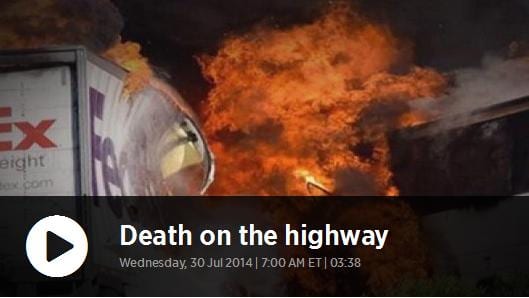Truck accidents remain a clear and present danger on the roads of Tennessee, and Stillman and Friedland share the concern of many drivers. As we noted in the first part of this series, this is a trend which has continued since 2009.
WATCH:

CNBC Investigations: Collision Course
According to Federal Motor Carrier Safety Administration (FCMSA) preliminary report released in November of 2016,
“In 2015, 4,311 large trucks and buses were involved in fatal crashes, an 8-percent increase from 2014… the number of large trucks and buses in fatal crashes has increased by 26 percent from its low of3,432 in 2009…”
The FCMSA also reports that Property Damage Only rates have remained constant or decreased by about 1%.
What policies could save more drivers? A major contributing factors to these accidents is the failure of trucking company safety directors to penalize or fire reckless drivers. In response to this problem, the Federal Department of Transportation (DOT) committed to establishing a database of drunk and/or drugged drivers:
“In 2012, Congress directed the Secretary of Transportation to establish a national Clearinghouse containing CMV operators’ violations of FMCSA’s drug and alcohol testing program in Section 32402 of the Moving Ahead for Progress in the 21st Century Act (MAP-21). This rule implements that mandate and also responds to earlier recommendations of the National Transportation Safety Board.”
This information was updated just last month, in December of 2016. As anyone can deduce, the mandate has languished without accomplishing its goal for a minimum of four years, although earlier recommendations also pointed to the need for action.
Obviously, since drivers who fail to drive responsibly are the core of the problem, restricting the number of reckless drivers on the road should be the primary goal of the authorities, whether local, state or federal. A key overall objective is reducing overall drunk and drugged driving, as DUI patterns indicate increases in the number of drugged drivers up between 12.5-20% nationwide.
In addition to getting proven bad drivers off the road, increasing safety awareness and identifying risky behavior may help. This includes spotting companies who engage in potentially negligent behavior. Data from the CDC in 2010 indicates that:
- An estimated 14 percent of long-haul truck drivers reported not using a seat belt on every trip.
- Over one-third of long-haul truck drivers had been involved in one or more serious crashes during their driving careers.
- Long-haul truck drivers who reported not wearing seat belts also tended to engage in other unsafe driving behaviors such as speeding and committing moving violations. They were also more likely to work for an employer that did not have a written workplace safety program.
As trucking continues to be an economical means of transporting goods, and the numbers of trucks continue to remain high, these issues remain a priority for Tennesseans. If you are concerned about keeping unsafe truck drivers off the road, urge your governmental representatives to move clearinghouse legislation forward. For now, your best protection is to be alert on the road and steer clear of heavy trucks when you are on the road.






